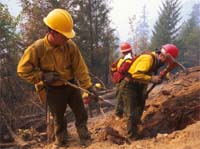 |
Fire
Management
Man and nature, the way it
starts, with control, suppression...
In the early decades of the 20th century, after several
catastrophic wildfires destroyed newly formed logging operations,
the U.S. government adopted a policy of aggressive fire
suppression. Professional firefighters were trained to detect
and fight fires, and tower lookouts were built in remote
sections throughout our country's forests. A forest ranger
would live in the lookout for weeks on end, catching up
on reading and watching for tell-tale wisps of smoke on
the horizon. From the time Yellowstone was established,
park managers did their best to suppress fires. Rule number
one in park fire-control policy was, let no fire get out
of hand.
The aim of fire suppression is,
first, to stop or slow down the rate of a fire's spread,
and secondly, to put it out. There are three components
to any fire — fuel, temperature, and oxygen —
which have become known as the fire triangle. To suppress
a fire, firefighters must break this triangle, by removing
the combustible materials, by reducing its temperature,
or by smothering it so that it has no oxygen.
| Suppressing fires became considerably
more effective after World War II and after the tragedy
of the Mann Gulch fire, when airplanes, helicopters,
smokejumpers, fire retardant clothes and new fire fighting
strategies were introduced into the fight against forest
fires. It seemed as if the raging infernos that had
destroyed forests and terrorized people would become
the gigantic disasters of the past, limited to small
outbreaks that could be quickly brought under control.
|

This photo, taken in October
of 2003, shows firefighters using fire retardant sprays
and digging tools to battle a blaze in California.
Image courtesy of the
National Interagency Fire Center. |
Worst-case scenario
On August 20, 1910, hurricane-force
winds sent fires careening through forests in Idaho
and Montana. Dubbed "the big blowup," these
fires destroyed 1,215,000 hectares of forest in just
48 hours. |
Perhaps the way it should be...let
it Burn
With the introduction of new equipment
and methods, firefighting efforts became more sophisticated
and more effective, as did the science of ecology, the study
of the relationships between organisms and their environment.
Ecologists began to doubt the wisdom of the policies of fire
suppression. Forests have always experienced periodic fires,
they argued. Before the arrival of humans, forests in the U.S.
West burned naturally every 25 to 30 years, and these fires
played an important role in the life cycle of the forests. Fires
get rid of dead or dying trees, clear away accumulated litter,
and refertilize the soil, allowing an increase in the variety
of plant and animal life. Since the beginnings of life on this
Earth as we know it, forests have adapted to the continuing
recurrence of fires. Foresters should not try to manipulate
forests, the ecologists cautioned: they should let nature, in
this case fire, take its course, and permit the forests to burn
naturally.
By 1972 the voices of ecologists were beginning
to be heard, and Yellowstone, like all the other parks in the
National park system, initiated a natural-burn fire policy.
The new policy let naturally occurring fires run their course
over about 15 percent of the park's total land area (provided
they did not pose a threat to visitor areas). By 1976 this policy
was expanded to all wilderness areas of Yellowstone, about 700,000
hectares.
Consequently, between 1972 and 1987, only
13,800 hectares of Yellowstone's 890,000 hectares of grasslands
and forests were overrun by fires. Tremendous amounts of decaying
litter and dead wood built up in Yellowstone's forests. Under
these conditions, when fires did occur, they quickly ballooned
into immense, uncontrollable conflagrations. Nowhere was this
more dramatically shown than in the Yellowstone fires of 1988.
We can handle that
Before the summer of 1988, the
worst fire in the history of Yellowstone Park (occurring
in 1886) had burned only 10,100 hectares. |

Review Questions
- What is the "fire triangle"?
- Firefighters attempt to suppress fires by: ________________, ________________,
and ________________
- Distinguish between a “fire suppression” policy and a "natural-burn" policy.
|
 |